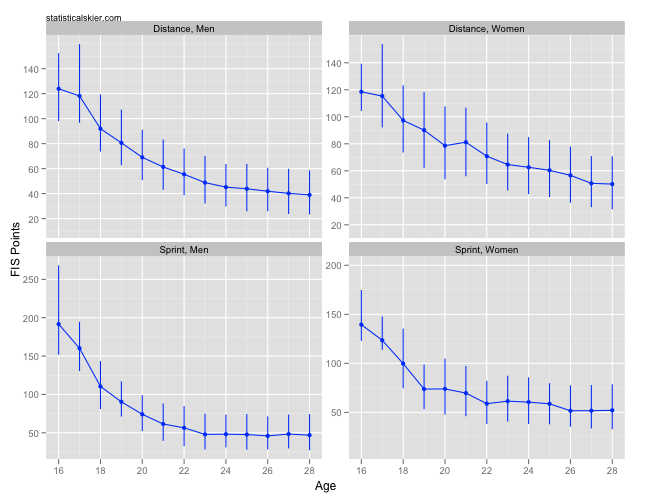Pete Vordenberg and Bryan Fish have an intriguing post up over at NCCSEF about the FIS point profiles of the top ten skiers in the world. The intention is to give developing skiers a rough tool to use to gauge their progress against the development paths of the best skiers in the world.
The FIS points awarded at any given race, of course, are intended to provide this sort of information, but that’s a comparison to the best skiers in the world right now, not the best skiers in the world when they were your age.
Also note that the term ‘FIS point profile’ means (I assume) the average of an athlete’s best five races over an entire calendar year that is used for generating the FIS point lists used in seeding. (Since this average is recalculated several times a year, I’m not sure which list they used at a given age; I presume they used the year-end list.)
My thoughts, as a stat-head:
- Ten skiers isn’t a huge ‘sample’ to learn from
- The sample is even smaller for many of the younger ages; for instance for the male sprinters it isn’t until age 21 that all ten have FIS point profiles
- The choice of display (four big sets of staggered columns of numbers) makes it hard to get sense of what a ‘typical’ FIS point profile is at a given age, and how much variability there is between athletes.
Let’s see if we can provide some similar information, geared towards the same purpose, but maybe in a format that’s a bit easier to digest. My version will be different in several respects, but my aim is still to provide a rough guide to where you stand compared to the best skiers in the world at a given age.
Rather than just the current top ten skiers in the world (however you choose to measure that), let’s instead look a bit wider at anyone who has achieved a top ten result in a major international competition (WC, OWG, WSC). Also, rather than looking at an athlete’s best results, let’s look at all the results achieved by top-ten caliber skiers at a given age. Here’s the result in chart form:
This graph extends all the way to age 28, although I think the ages we’re really interested in here don’t extend much beyond 25 or so.
The trend line marks the median FIS point result for top-ten caliber skiers at a given age. The vertical bars represent the 25th-75th percentile of these results (i.e. the middle 50%).
So for example, for female distance skiers who at some point in their career achieved a top ten result, the median FIS point race at age 20 was just north of 75, and half of these skier’s results at age 20 fell roughly between 55-105. (If you’re good at processes of elimination, you’ll have figured out that 1/4 were better than this, below 55, and 1/4 were worse, above 105.)
A convenient age for Americans to look at is 22, roughly corresponding to when students here graduate from college:
| Gender | Type | 1st Quartile | Median | 3rd Quartile | N |
| Men | Distance | 38.69 | 55.46 | 76.09 | 1510 |
| Men | Sprint | 32.65 | 56.47 | 84.88 | 642 |
| Women | Distance | 50.26 | 70.82 | 95.75 | 1235 |
| Women | Sprint | 38.23 | 58.88 | 82.13 | 445 |
This chart should be fairly self-explanatory. The final column is simply the number of race results in that category. So there were 1510 results from male future top-ten finishers at the age of 22.
This would suggest that a decent benchmark for male skiers is to be routinely skiing at ~55 FIS points by the time they’re 22, in both sprint and distance events. For 22 year old women, they might want to be aiming for routinely skiing at a level of ~71 FIS points in distance events and ~59 FIS points for sprinting.
When I say ‘routinely’, I mean that should be a ‘middle of the road’ result, not one of your best results.
I will also reiterate what Vordenberg wrote in his post, which is that benchmarks like these using FIS points are far from the whole story, and should be used fairly loosely. But it is probably a decent indicator, particularly in extreme cases.
[ad#AdSenseBanner]

{ 1 } Comments